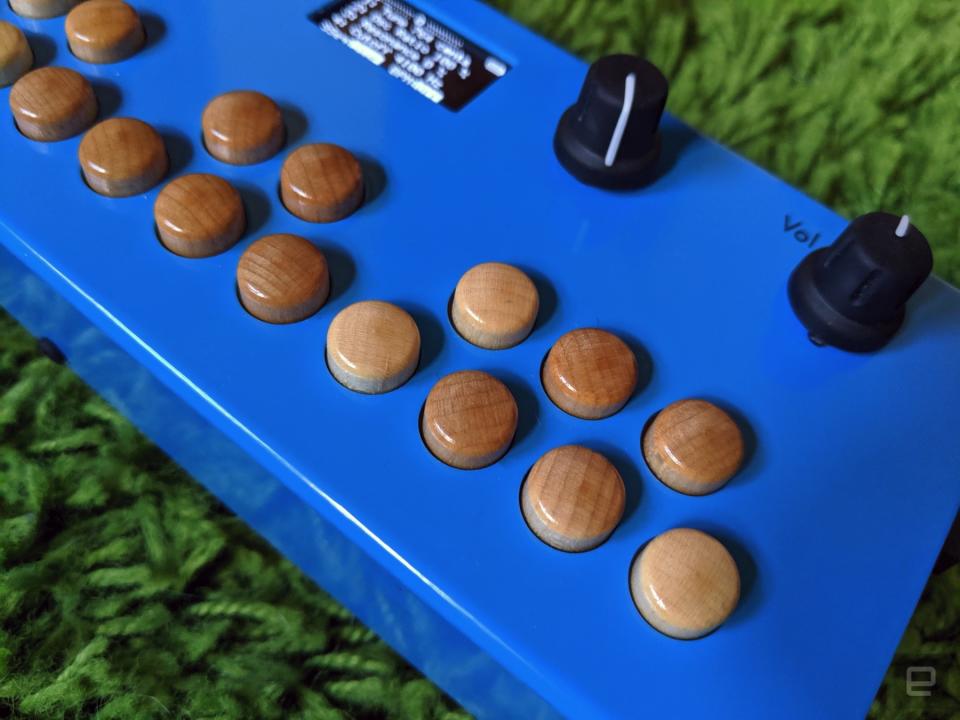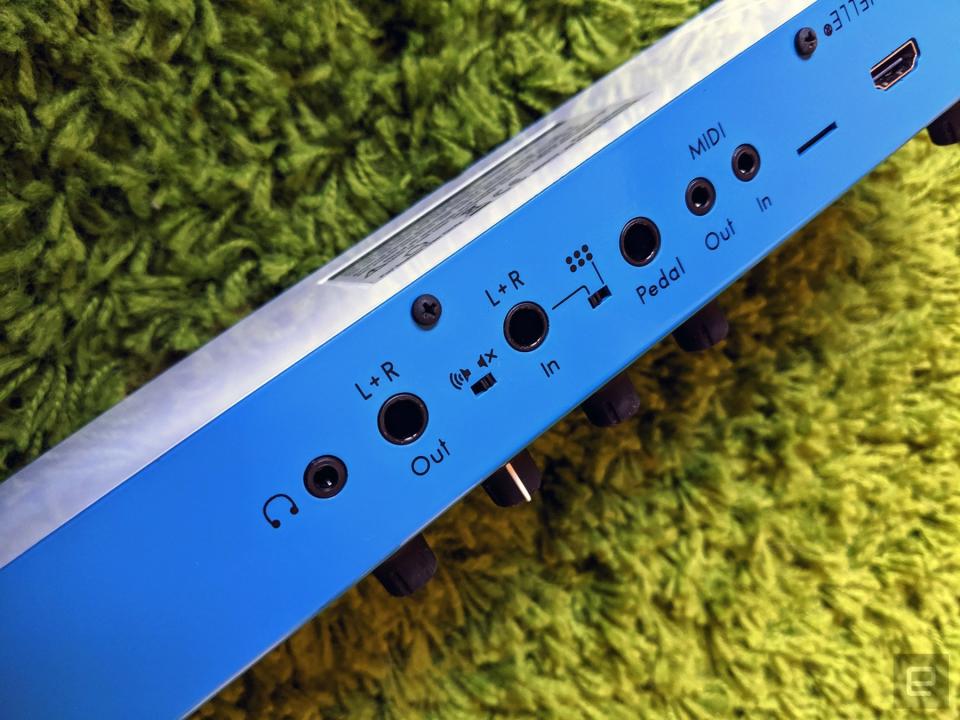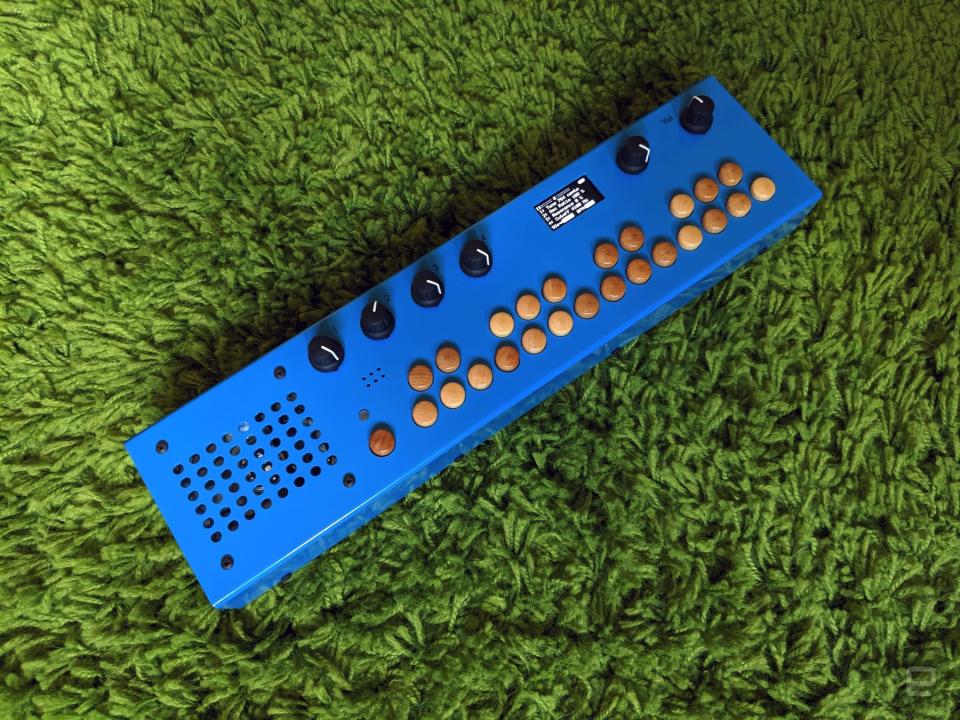The Organelle is a music computer that can do almost anything
... if you have the will and patience.
Not long ago, "portable" was basically a synonym for "toy" when it came to keyboards and synthesizers. Sure, a classic Casio like the VL-1 is not without its charms. But it's not exactly a serious musical instrument. That's changed a lot in recent years, partially due to miniaturization and clever engineering but mostly thanks to the relentless march forward of computing power. Perhaps no device is more emblematic of this than Critter & Guitari's Organelle. It is, at its core, a computer, and I don't mean that in the same broadly defined way that almost all electronics are computers. I mean that inside there's a Raspberry Pi running Linux.
It's this fact that makes the Organelle so unique and flexible. Unlike other portable music gadgets, like the Pocket Operator, that focus on being a drum machine or a sampler, the Organelle tries to be all the things. It's a synthesizer, a sampler, a sequencer, an effects processor -- almost anything someone with the right coding skills can dream up. But there is a danger in trying to be a jack-of-all-trades: You often end up as a master of none.
What is it?

The Organelle is able to cover so much ground because it runs patches built in Pure Data (Pd), an open-source, visual-programming language focused on creating and manipulating audio. Now, these patches should theoretically run on almost any computer or smartphone (Pd is cross-platform). But thankfully using the Organelle isn't like using a computer. It is first and foremost an instrument. While it can be connected to a monitor and mouse, it's designed to be played using the two-octave keyboard and knobs on the front. Once you've loaded a patch, it doesn't feel that different from playing any other portable synth or sampler.
Of course, there are some differences. The most obvious is the keyboard. It has round, maple-wood keys that look great and give the Organelle a fun, quirky vibe but definitely take a little getting used to. They're no bigger than the touch keys on a Korg Volca (though they're more generously spaced) and take slightly more effort to depress than your typical piano-style MIDI controller. It's still easy enough to pluck out melodies and finger simple chords though. And again, they look pretty damn cool.
Dust is a decidedly lo-fi keyboard / synth patch that can go from subtle vinyl crackle to radioactive decay. The LFO can impart a subtle VHS-like warble or go full cartoon meltdown.
The bigger difference lies in how you deal with tweaking your sound. On something like the Volca Keys, for instance, there's a dedicated knob for everything you can change. On the Organelle, however, the parameters you can adjust are different from patch to patch, and there are a limited number of controls on the front. There's an aux key, four parameter knobs and one selection knob at your disposal. And each patch can make use of those controls in a different way. On a simple synth, the four parameter knobs might give you quick access to the filter while the aux key triggers the sequencer. On a sampler the aux key might be how you record audio. And on something more complex, the aux key or selection knob might be used to switch through multiple pages of settings. For some patches there can be quite a bit of menu diving. For example, Juno-104 (an excellent emulation of the iconic Juno-106) has eight pages of settings. And while I can turn on that oh-so-1980s chorus from the first page, I have to hit the aux key six times if I want to soften the attack to change from a sharp bass to a pad.
Feeling your way around
This is ultimately the Organelle's greatest weakness: a lack of consistency. But to be clear, this is not a flaw in the design. It is simply a byproduct of its approach. See, while Critter & Guitari has built dozens of patches itself, part of the allure is that anyone can create their own and share it with other Organelle owners. But there's no way to ensure that every person who decides to dabble in Pd abides by the same interface rules or implements every feature in the exact same way.
This patch is based on the original Rhythmicon invented by Henry Cowell and Leon Theremin, one of the first drum machines ever built.
This means that every time you install a new patch, you'll probably have to spend some time learning how it works. Some are fairly straightforward, but others might require a solid 20 minutes and a cheat sheet to figure out. And you'll be lucky if there is a cheat sheet. Documentation for many patches is either lacking or nonexistent. Again though, we're talking about people designing and building software instruments in their spare time and giving them away for free. It's kinda hard to complain.
What can it do?

By my count there are just shy of 400 patches for the Organelle on Patchstorage.com (a site dedicated to hosting patches for music-making hardware and software like Empress Effects' Zoia and SuperCollider). Of course, the quality of those patches varies greatly. Critter & Guitari's first-party patches are all pretty solid, especially the more recent ones. And they all have excellent documentation and demo videos that walk you through how they work.
The community patches are a little all over the place. There are some amazing ones and others that were clearly abandoned after being released, still rife with bugs. They range in complexity from simple guitar tuners to recreations of popular Eurorack synth modules like the beloved Braids from Mutable Instruments. There are even patches that combine a synthesizer with a generative sequencer and effects, so you can set the Organelle loose and it will create its own constantly evolving melodies drenched otherworldly reverb.
My favorite use for the Organelle so far has been to manipulate external audio either as an effects processor or as a sampler/looper. For example, DJ Patch Record lets you capture a sample and then play it back at two different speeds or in two different directions simultaneously. Then the keyboard moves the second playhead around relative to the first to create stuttering, glitchy patterns. It's especially fun to apply this sort of obviously artificial effect to something organic like an acoustic guitar. The Organelle excels at this kind of experimental audio mangling.
DJ Patch is a looper with two play heads that can operate at different speeds and directions simultaneously. In this demo I start with a simple guitar loop, then bring in the second playhead at double speed. A MIDI controller is also used to "arpeggiate" the position of the second play head in relation to the first creating skips and jumps.
I'm even able to plug my electric guitar into the audio port on the back and get a number of effects that otherwise would require that I buy multiple expensive pedals like Infinite Jets from Hologram Electronics or Particle from Red Panda. Those pedals list for $425 and $299, respectively, so being able to get a facsimile of them in a box that costs $595 is pretty good. Now, these are not 100-percent faithful recreations, but they get close enough. If nothing else, they'll help you figure out if those admittedly bizarre effects are for you before you throw another couple hundred dollars at music gear.
In general, the sounds you get here are excellent but not quite on par with a dedicated high-end-effects unit. I don't own an H9 from Eventide, but based on the demos I've seen, its reverb and delay algorithms are beyond what has been created for the Organelle (at least so far). That being said, the H9 can cost as much as $699 and is focused exclusively on being a stomp box for a guitar. It simply can't do the advanced sample manipulation or synthesis that the Organelle can. And if the H9 is missing an effect you want, you're basically SOL, where as on the Organelle, if you have the coding chops, you can build the effect of your dreams.
Talking to the Organelle

So how hard is it to build your own patches? Well, that all depends on your comfort level with coding in general. The core of Pd is placing objects and then basically connecting them with virtual cables. Building something in Pure Data and its close relative Max is much easier than, say, wrapping your head around C++, but if you've never had a mind for programming, don't expect things to be much different here.
If you are going to dive in, one quick tip: Have a blank template saved, and when you're ready to start building a patch, launch it from the Organelle itself rather than the desktop. That will automatically load all the correct MIDI mappings, et cetera, for the Organelle's controls.
A combination of 808 samples recorded to tape and a simple sequencer that's designed especially for creating complex polyrhythms.
Normally though, if you're going to connect anything to those USB ports, it's going to be a MIDI controller or the WiFi adapter that Critter & Guitari includes in the box. Every USB MIDI controller I've tried with the Organelle has worked fine. However, I'll admit the process of getting them up and running could be smoother. You have to navigate a few menus deep, select the controller manually, then scroll down and hit save.
Similarly, getting the WiFi adapter connected to your network is a little bit of a roundabout process. It's not dissimilar from getting a Chromecast or a smart speaker set up: First you have to connect to the Organelle directly using your phone or laptop, then using a web interface tell it your WiFi credentials.
That web interface is also how you manage patches, and again, the process is simple but a little rough around the edges. Once it's up and running on your WiFi network, you need to select "start web server" from the WiFi settings menu, then point your browser to https://organellem.local. Here you click "patch manager" and you're greeted with a simple file manager. If you've ever used the web interface for Dropbox you should be comfortable. Last, you upload patches in .zip format and then move over to the Organelle itself to select "Install (fill in the blank)."
What's new?
None of this is new, though. This is more or less how the Organelle has operated since it first launched in 2016. What's new in 2019 is mostly the hardware. The new model, sometimes referred to as the Organelle M, has a number of major upgrades from the original.
Let's start with what I'd argue is the least important: the Raspberry Pi. The OG Organelle had a single-core 1GHz 32-bit ARM A9 chip and 512MB of RAM. The Pi 3 on the other hand has a quad-core 1.2GHz 64-bit ARM Cortex-A53 and 1GB of RAM. In short: it's much more powerful. Right now though, there aren't many patches that take advantage of that increased horsepower. That may change eventually, but for now you're mostly talking about an extra note of polyphony in a patch here and there, like Supersynthengine, an incredibly deep analog-style synth that excels at retro lo-fi pads.
Supersynthengine is very deep analog-style synth with multiple effects, modulator options and presets.
The other changes are much more immediately useful. For one, it has MIDI ports. Granted, they're of the TRS Type A variety, so you'll need an adapter if you want to connect to a traditional five-pin MIDI DIN. But in general, having actual MIDI on board made it much easier to integrate with the rest of my setup. It was simple enough to connect the Model:Samples and keep the two locked in step.
The other upgrades here are focused on making the Organelle more portable and immediate. And honestly, they change the instrument in fundamental ways. The most important is the ability to power it with four AA batteries. For something where portability was always a big part of the pitch, having to be tethered to an AC adapter was a real bummer. I've been able to drag the new Organelle all over NYC -- to a busy bar, on the Staten Island Ferry, to my parents' house -- and I've never had to find an outlet to spend a few minutes jamming. Critter & Guitari says you'll get roughly five hours of play, though I averaged closer to four. That can take a real nose dive if you turn the WiFi on.

Also helpful is the addition of a speaker. While obviously it would be rude to blast the Organelle on the bus, it's nice to be able to sit on my steps or move from the couch to the kitchen without having to worry about extra cables or headphones. And the speaker sounds pretty damn good. It's surprisingly loud and frankly blows the speakers on other portable music gadgets out of the water. It's about on par with what you'd find in a small smart speaker, like a Google Home Mini.
Last, there's a microphone on board now. Since one of the Organelle's strengths lies in sampling and manipulating audio, not having to plug in an external mic is great. It mostly gets the job done if you're just looking to have fun, but don't expect it to capture crystal-clear audio. The results definitely have a decidedly lo-fi vibe, but that might be exactly what you're going for. One quick word of warning though: Keep that mic turned off when you're not using it (there's a switch on the back). Some patches have the input level turned up by default, and if you have the speaker turned up too high, it can cause some rather unpleasant feedback.
According to Mutable Instruments, Clouds "is focused on the realtime granularization of incoming audio signals, and their transformation into amorphous textures." ¯\_(ツ)_/¯ This is what a recreation of it on the Organelle did to my guitar.
All these things have combined to make the Organelle my new go-to couch instrument. When I'm hanging out around the apartment, I find myself reaching for it constantly and taking it with me from room to room. I'll take short samples of my son banging on his piano or saying something silly and then warp it until it's completely unrecognizable. And I've started sticking it between my guitar and my amp whenever I sit down to play so I can tap into some of its more experimental looping and reverb patches. It has not replaced Teenage Engineering's PO-33 KO as my go-to commuting instrument, though. The Organelle is a tad too big and bulky to take with me everywhere. It's more than 13 inches long and nearly 1.7lbs with batteries installed. That's hardly unmanageable, but it's a bit much to be tossing in a bag just in case I have some downtime.
Wrap-up

Honestly, it's kinda hard to review something like the Organelle. It's a truly unique device with little in the way of direct competition. But it's also for a particular type of person. It's for adventurous sonic manipulators and those looking to dabble in building their own custom Pd patches. If you just want something for knocking out acid bass lines while you're riding the bus, Organelle is probably overkill. But if you're willing to put in the time and effort, it can become an indispensable Swiss Army knife in your music-making setup.



